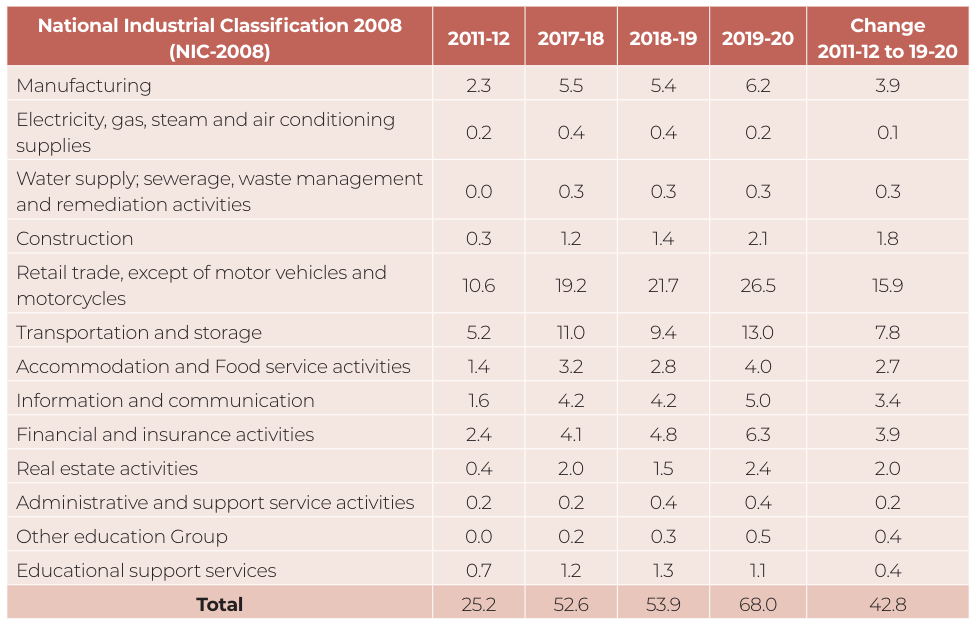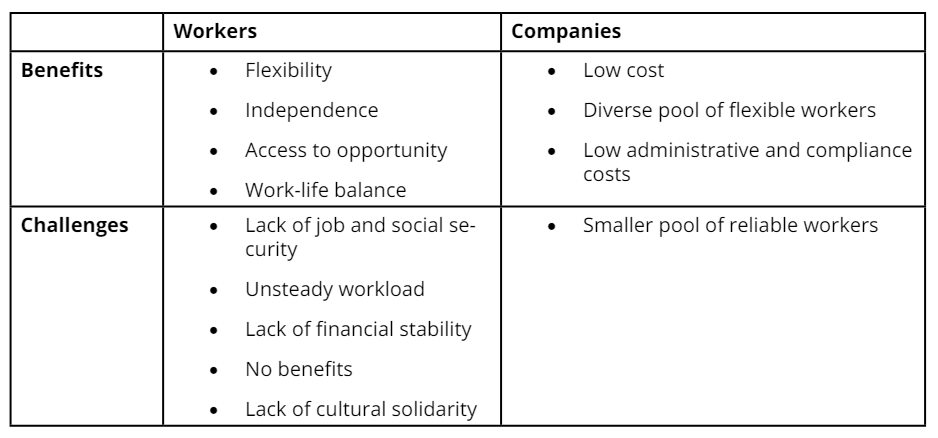
In the Present and Towards the Future of Gig Economy and Workers in India
Ordering food, clothes, materials and so on online has become a routine exercise for all of us. In this routine exercise, there 3 players, the first one is customer, then the provider or aggregator and the thirdly the delivery or service partner. We frequently hear news about these delivery partners of different kinds.
This article focuses on economic and job angle of these delivery or service partners who are known as the ‘GIG WORKERS‘ and hence the terminology ‘GIG ECONOMY’.
Over the past decade, there has been a shift in the traditional labour market with a rise in freelance and task-based economies. This is accelerated by the emergence of digital platforms, making it easier to connect job seekers with job providers at low cost and maximum flexibility.
Examples of blue-collared work in this economy include delivery boys, drivers, cleaners, whereas white-collar work includes digital marketers, bloggers, designers, etc.
Why is it important to know and understand intricacies?
Because the gig economy and gig workers are forming the future of work and jobs. They are a part of our present and will have an impact on us as either we become the part of gig economy as a customer or a provider or a worker.
The lucrative looking model of gig economy is providing jobs and facilitating services for many, but if we want it to be continued then ensuring and practicing labour dignity is required.
Who are these workers?
The Social Security Bill, 2020 first time officially announced and included the word ‘gig’ in the code. According to which, gig workers are those engaged in livelihoods outside the traditional employer-employee arrangement. They can be broadly classified into platform and non-platform-based workers.
Platform workers are those whose work is based on online software apps or digital platforms dedicated to ride-hailing, food, grocery, medicine delivery, logistic fulfilment, e-commerce and online shopping. Non-platform gig workers are generally casual wage workers and own-account workers in the conventional sectors, working part-time or full time.
Some Statistics...
While understanding the growth of gig economy and number of workers associated with it, NITI Aayog, Government of India’s think tank ahs launched a report titled ‘India’s Booming Gig and Platform Economy’, 2022.
The report estimates that in 2020–21, 77 lakh (7.7 million) workers were engaged in the gig economy. They constituted 2.6% of the non-agricultural workforce or 1.5% of the total workforce in India. The gig workforce is expected to expand to 2.35 crore (23.5 million) workers by 2029–30.
Gig workers are expected to form 6.7% of the non-agricultural workforce or 4.1% of the total livelihood in India by 2029–30.
At present, about 47% of the gig work is in medium skilled jobs, about 22% in high skilled, and about 31% in low skilled jobs. Trend shows the concentration of workers in medium skills is gradually declining and that of the low skilled and high skilled is increasing.
The report finds that they are largely working in the non-agricultural sectors and mostly in the urban areas. The detailed industry-wise classification is provided in the figure below.

In terms of occupation in 2019-20, about 22 lakh workers were sales and marketing persons, about 12 lakh were motor vehicle drivers, about 6 lakh were secretaries and clerks, about 5 lakh sales and finance associates, and others. Between 2011-12 and 2019-20, the largest addition in the gig economy was shop sales and market sales persons which increased by 12 lakh workers, followed by drivers which increased by 8.5 lakh.

TeamLease Services claims that around 56% of new jobs in India – both blue and white collar – are being generated by the gig economy. Almost one out of four gig workers worldwide are in India, states Ernst & Young (E&Y).
Benefits and Challenges of Lucrative Business & Job
The gig economy in India flourishes unregulated to a great extent as platforms recognise these workers as ‘contract workers’ which denies these workers employee benefits such as access to minimum wages, overtime compensation, annual leave, severance pay, pension pay, employee provident fund (EPF) accounts and anti-discrimination laws. Gig workers are subjected to algorithmic surveillance, reducing transparency and accountability mechanisms between workers and platforms. Such algorithmic surveillance also affects workers’ daily wages and may encourage discrimination.

Way Forward
The growing number of Indians reliant on the gig economy necessitates government intervention to uphold their labour rights with humane labour practices. The State of Rajasthan showed the way by enacting the Rajasthan Platform Based Gig Workers (Registration and Welfare) Bill, 2023. The law defines aggregators as a ‘digital intermediary… and includes any entity that coordinates with one or more aggregators’.
The State Government of Rajasthan has applied a surcharge of up to 2% on transactions, with the generated funds being channelled into a welfare fund overseen by a board encompassing representatives from the workers, industry, and government sectors
Following Rajasthan, State Government of Karnataka is also planning to provide social security benefits to gig workers. Santosh Lad, the Labour Minister of Karnataka, said that the government is actively considering the option of imposing an additional service tax for the purpose of supporting gig workers’ welfare initiatives. State authorities have indicated that a welfare board for transport workers is under contemplation, potentially encompassing the collection of a cess to finance their welfare programs. It is being explored whether the gig workers could also be integrated into this same board.
In a nutshell, first there is need to properly define the gig workers so that following government laws and regulations will protect both employer and employees. Secondly, the workers are offered life and accidental insurance through already existing schemes for which mass-level awareness should be generated for workers enrolment as the beneficiary. Lastly, it is the societal responsibility to understand and accept present-day and future changing nature of jobs and work and accordingly treat these gig workers with equal amount of respect and dignity.

Vaibhavi Pingale
Ms. Vaibhavi Pingale is a Visiting Faculty of Economics at Gokhale Institute of Politics and Economics, Pune & at Savitribai Phule Pune University. She is pursuing her PhD. She has been actively writing media articles other than academic research.

